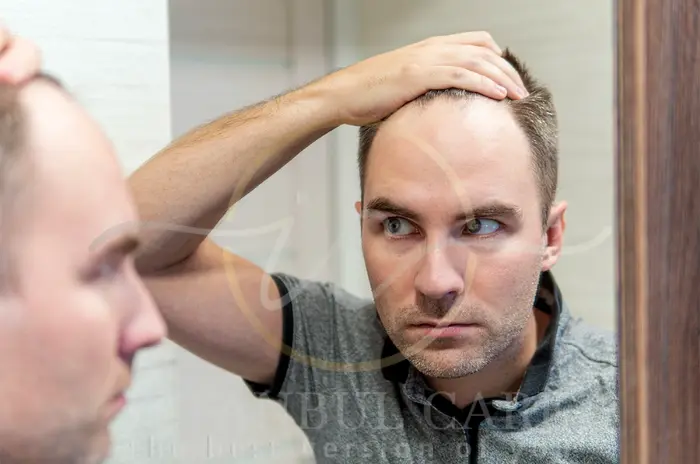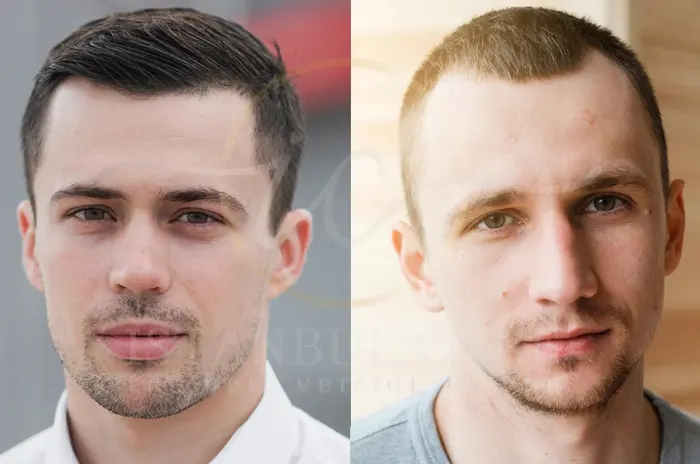Dealing with a receding hairline can feel overwhelming, but the right haircut can transform your appearance and boost your confidence. Whether you’re noticing early signs of hair thinning or looking for ways to enhance your existing style, understanding which hairstyles for men with thinning hair work best is crucial for maintaining a sharp, modern look.
Fluffy hair techniques and strategic styling can create the illusion of fuller coverage while working with your natural hairline. The key lies in choosing cuts that complement your face shape, hair texture, and the specific pattern of your hair loss. From classic crew cuts to modern textured crops, there are numerous best haircuts for receding hairline that can help you look and feel your best.

Understanding Receding Hairlines in Men
What Is a Receding Hairline?
A receding hairline occurs when hair begins to thin or disappear from the temples and forehead area, creating an M-shaped pattern. This natural process affects millions of men worldwide and typically begins in the late twenties or early thirties. The hairline gradually moves backward, often starting at the corners before progressing toward the crown.
Male pattern baldness, scientifically known as androgenetic alopecia, is the primary cause of receding hairlines. This hereditary condition affects hair follicles’ sensitivity to dihydrotestosterone (DHT), a hormone that shrinks follicles over time. Understanding this process helps in selecting appropriate haircuts to hide receding hairline effectively.
Early Signs and Causes of a Receding Hairline
The first signs of a receding hairline often appear as subtle changes in the temple area. You might notice increased hair shedding during washing or styling, or see more scalp showing through your hair. The hairline may begin to form a widow’s peak or create deeper recessions at the corners.
Genetics play the most significant role in determining when and how quickly hair recession occurs. However, factors like stress, hormonal changes, certain medications, and aggressive styling can accelerate the process. Recognizing these early signs allows you to adapt your styling routine and choose receding hairline men’s haircut options that work with your changing hairline.
How Receding Hairlines Affect Your Style Choices
A receding hairline doesn’t mean limiting your style options – it means making smarter choices. Traditional longer hairstyles that rely on a full hairline may no longer be suitable, but this opens opportunities for more mature, sophisticated looks. Short haircuts for receding hairlines often appear more polished and professional.
The key is understanding which styles draw attention away from thinning areas while highlighting your best features. Modern fade haircut for thinning hair techniques can create seamless transitions that minimize the appearance of hair loss. Strategic layering and texturing can also add volume where it’s needed most.
Best Haircuts to Try for Receding Hairlines
| Haircut Style | Best For | Maintenance Level | Hair Length Required | Professional Setting |
|---|---|---|---|---|
| Buzz Cut | Advanced recession, low maintenance | Very Low | Very Short (1-3mm) | Excellent |
| Crew Cut | Most face shapes, versatile | Low | Short (6-12mm top) | Excellent |
| Fade (Taper) | Modern look, sharp lines | Medium | Short to medium | Excellent |
| Textured Crop | Fine hair, adding volume | Medium | Short (10-15mm) | Good |
| Ivy League | Professional environments | Medium | Medium (15-25mm) | Excellent |
| Comb Over | Moderate recession | Medium | Medium (20-30mm) | Good |
| Slicked Back | Mature look, confidence | High | Medium to long | Excellent |
Buzz Cut: Simple and Low Maintenance
The buzz cut receding hairline approach offers the ultimate in simplicity and confidence. By keeping hair uniformly short across the entire head, you eliminate contrast between thick and thin areas. This style works particularly well for men with advanced recession or those who prefer minimal styling.
A buzz cut creates a clean, masculine appearance that requires virtually no daily maintenance. The uniform length means your receding hairline becomes less noticeable because there’s no longer hair to create unflattering contrasts. This style also works well with facial hair, creating a balanced, rugged look.
Crew Cut: Classic Style for Thinning Hair
The crew cut for receding hairline remains one of the most versatile and flattering options available. This timeless style keeps hair short on the sides while leaving slightly more length on top, allowing for subtle styling without exposing thin areas. The graduated length creates natural volume and texture.
This best hairstyles for receding hairlines option works well for both professional and casual settings. The crew cut can be customized to suit different face shapes and hair textures while maintaining a clean, polished appearance. Regular trims every 3-4 weeks keep this style looking sharp and well-maintained.
Comb Over: Adds Volume and Covers Receding Areas
The modern comb over for thinning hair has evolved far beyond its outdated reputation. Today’s versions use strategic parting and styling to create natural-looking coverage without appearing artificial. The key is keeping the contrast subtle and the styling relaxed.
This men’s haircuts for thinning hair option works best when the hair is kept relatively short and styled with lightweight products. Avoid harsh parts or overly dramatic sweeping motions that can look unnatural. Instead, opt for a gentle side part that follows your natural growth patterns.
Taper Fade: Blends the Hairline for a Clean Look
The high fade receding hairline technique creates a seamless blend from longer hair on top to very short sides. This gradient effect draws attention upward while minimizing the appearance of temple recession. The clean lines of a taper fade create a sharp, contemporary look.
This fade haircut for thinning hair style offers excellent versatility in terms of the fade’s starting point and intensity. A high fade begins closer to the temples, while a mid or low fade starts lower on the sides. The choice depends on your comfort level and the extent of your hair recession.
Textured Crop: Adds Depth and Minimizes the Hairline
The French crop for receding hairline utilizes strategic texturing and layering to create the illusion of fuller hair. This modern style keeps hair short overall while using choppy, uneven layers to add volume and movement. The textured finish helps disguise thin spots naturally.
Textured layering men techniques involve cutting hair at different lengths to create depth and dimension. This approach works particularly well for men with fine or straight hair, as the varied lengths catch light differently and create the appearance of greater density.
Ivy League: A Polished Look with Styling Flexibility
The Ivy League cut offers a sophisticated take on the crew cut, with enough length on top for styling versatility. This best haircuts for receding hairline option allows for both slicked-back and forward-styled looks, making it perfect for professional environments.
This style maintains shorter sides while leaving sufficient length on top for various styling options. The classic nature of the Ivy League cut means it never goes out of style, making it a safe choice for men who prefer traditional, refined appearances.
Slicked Back Hair: Ideal for Mature Hairlines
Slicked-back styles work exceptionally well for men with widow’s peak hairstyles or moderate recession. By styling hair straight back, you create clean lines that complement rather than fight your natural hairline. This approach requires confidence but delivers a distinguished, mature appearance.
The key to successful slicked-back styling lies in using the right products and techniques. Medium-hold pomades or gels provide control without creating a helmet-like appearance. This style works best with regular professional cuts to maintain proper proportions.

Styling Tips to Make Receding Hairlines Less Noticeable
Use Volumizing Products for Fuller Appearance
Fluffy hair textures can be achieved through strategic product selection and application. Volumizing mousses, texture sprays, and lightweight pomades help create lift and body without weighing hair down. These products work best when applied to damp hair before styling.
Sea salt sprays and dry shampoos can add grip and texture to fine hair, making it appear fuller and more substantial. Avoid heavy oils or thick styling creams that can make thin hair appear flat and lifeless. The goal is to enhance your natural texture while adding volume.
Avoid Tight Styles That Pull the Hairline Back
Tight ponytails, slicked-back looks with strong hold products, or any style that creates tension at the hairline can accelerate hair loss through traction alopecia. Receding hairline haircuts should work with your natural growth patterns rather than against them.
Gentle styling techniques preserve existing hair while preventing further damage. Use soft-bristled brushes, avoid excessive heat styling, and never pull or tug on wet hair. These practices help maintain the health of your remaining hair and prevent unnecessary stress on follicles.
Choose a Hair Part That Suits Your Hairline
Side parting for thinning hair can effectively disguise recession when positioned correctly. The part should follow your natural crown patterns and avoid creating harsh lines that emphasize thin areas. Experiment with different positions to find what works best for your specific hairline.
A slightly off-center part often looks more natural than a severe side part or center part. The goal is to create balance and draw attention to your best features while minimizing the appearance of hair loss. Professional stylists can help determine the most flattering part placement.
Keep the Sides Short to Focus on the Top
Short haircuts for receding hairlines benefit from maintaining contrast between the top and sides. Keeping sides trimmed short draws attention upward to where you have more hair coverage. This technique creates the illusion of fuller hair on top while maintaining clean, sharp lines.
Regular maintenance of the sides is crucial for this approach to work effectively. Schedule trims every 2-3 weeks to keep the contrast sharp and prevent the style from looking unkempt. This frequent maintenance investment pays off in consistently polished appearance.
Use a Matte Finish for Natural Texture
Matte-finish styling products create more natural-looking texture than high-shine alternatives. Textured brush forward hairstyle techniques work best with products that enhance natural movement without creating obvious styling effects. Clay-based products and matte pomades offer excellent control with natural finishes.
Avoid overly shiny products that can make thin areas more apparent by creating reflective surfaces. Matte finishes help disguise sparse areas by diffusing light rather than reflecting it directly. This subtle difference can significantly impact the overall appearance of hair density.
When to Consider Hair Treatments or Alternatives
Are Hair Transplants Right for Receding Hairlines?
Hair transplant procedures have become increasingly sophisticated and natural-looking for treating receding hairline issues. Modern techniques like FUE (Follicular Unit Extraction) can restore hairline density with minimal scarring and natural-looking results. However, these procedures require significant investment and recovery time.
Ideal candidates for hair transplants have stable hair loss patterns and sufficient donor hair for redistribution. The procedure works best for men with moderate recession rather than advanced baldness. Consultation with qualified specialists helps determine whether transplantation is a viable option for your specific situation.
Scalp Micropigmentation as a Styling Solution
Scalp micropigmentation (SMP) offers a non-surgical alternative for enhancing the appearance of hair density. This technique uses specialized tattooing to create the illusion of hair follicles, effectively camouflaging thin areas and creating the appearance of a fuller hairline.
SMP works particularly well in combination with buzz cut receding hairline styles, as it can create the appearance of a naturally full head of recently shaved hair. The procedure requires multiple sessions but offers permanent results with minimal maintenance requirements.
Embracing the Bald Look with Confidence
Clean shave receding hairline approaches eliminate the stress of managing thinning hair entirely. Many men find that fully embracing baldness actually enhances their appearance and confidence. This option works particularly well for men with strong facial features and good head shape.
The key to successfully carrying a bald look lies in maintaining overall grooming standards. Regular head shaving, moisturizing, and sun protection become important parts of your routine. Many men discover that this bold choice actually simplifies their daily grooming while projecting confidence and masculinity.
How to Choose the Right Haircut for Your Receding Hairline
Consider Your Face Shape & Hair Texture
Men’s haircuts for thinning hair must complement both your facial structure and hair characteristics. Round faces benefit from styles that add height on top, while square faces work well with softer, textured approaches. Understanding your face shape guides you toward the most flattering receding hairline haircuts.
Hair texture plays an equally important role in style selection. Fine, straight hair requires different approaches than thick, wavy hair. Fluffy hair textures can be enhanced through strategic cutting and styling, while naturally coarse hair might benefit from shorter, more controlled styles.
Opt for Layers or Texture to Add Volume
Textured layering men techniques create the illusion of fuller hair through strategic cutting angles and varied lengths. Layers catch light differently and create movement that disguises thin spots naturally. This approach works particularly well for men with fine or straight hair textures.
Professional stylists can create custom layering patterns that enhance your specific hair type and growth patterns. The key is subtle variation rather than dramatic layering that might emphasize thin areas. Proper layering requires skilled execution and regular maintenance to remain effective.
Avoid These Hairstyles (Worse for Thinning Hair)
Certain styles can actually emphasize hair loss rather than disguising it. Long, straight styles often appear stringy and thin, while center parts can create unflattering divisions that highlight sparse areas. Overly voluminous styles can look artificial and draw attention to the contrast between thick and thin areas.
High pompadour styles require significant hair density to look natural and can expose receding temples. Similarly, tight braids or ponytails can cause additional hair loss through traction while emphasizing existing thin areas. Understanding which styles to avoid is just as important as knowing which ones work well.
Consult a Barber for Personalised Advice
Professional barbers and stylists bring expertise in working with various hair loss patterns and can recommend best hairstyles for receding hairlines based on your specific needs. They understand how different cutting techniques affect the appearance of hair density and can create custom solutions.
A skilled professional can also teach you proper styling techniques and recommend suitable products for your hair type and chosen style. This investment in professional guidance often saves time and frustration while ensuring consistently good results.

Why Choose the Right Hairstyle for a Receding Hairline
How a Haircut Can Disguise Hair Recession
Strategic haircuts to hide receding hairline work by redirecting visual attention and creating optical illusions of fuller coverage. Proper cutting techniques can minimize the appearance of thin areas while enhancing your natural features. The right style choice can literally take years off your appearance.
Fade haircut for thinning hair approaches create seamless transitions that eliminate harsh contrasts between thick and thin areas. These techniques require understanding of hair growth patterns and skillful execution to achieve natural-looking results that enhance rather than expose hair loss.
When to Consider Hair-Restoration Options
Hair-restoration treatments become worth considering when styling alone cannot achieve satisfactory results. This typically occurs when hair loss becomes too advanced for traditional styling solutions or when personal satisfaction with appearance significantly decreases.
Modern restoration options range from topical treatments and medications to surgical procedures and non-invasive alternatives like SMP. The decision should be based on realistic expectations, budget considerations, and consultation with qualified professionals who can assess your specific situation.
Hairstyles to Avoid with a Receding Hairline
Combover – A Styling Faux-Pas
Traditional comb over styles that attempt to sweep long hair over bald areas often look artificial and can actually draw more attention to hair loss. These outdated approaches lack subtlety and can appear desperate rather than confident. Modern alternatives offer much more natural-looking solutions.
The key issue with traditional combovers lies in their reliance on dramatic contrast and obvious manipulation of hair direction. When wind or movement disturbs the carefully arranged hair, the illusion is broken and the hair loss becomes even more apparent than if left unstylied.
High Pompadour – Too Exposing for Hair Loss
High pompadour styles require significant hair density and a strong hairline to look natural. These voluminous styles can emphasize receding temples and draw attention to areas where hair is sparse. The contrast between the styled hair and exposed scalp becomes too obvious.
Additionally, creating and maintaining a pompadour requires extensive styling and strong-hold products that can stress remaining hair. The daily manipulation and product buildup can potentially accelerate hair loss in already vulnerable areas.
Tight Hairstyles – Risk Further Hairline Damage
Any style that creates tension at the hairline poses risks for further hair loss through traction alopecia. This includes tight ponytails, severe slicked-back looks, or any style that pulls hair taut from the roots. The constant tension can damage hair follicles permanently.
Men’s fringe receding hairline styles should avoid pulling hair forward too tightly or creating harsh lines that emphasize the recession. Gentle styling techniques preserve existing hair while preventing additional damage from styling practices.
Dreadlocks – Can Cause Traction-Induced Hair Loss
Dreadlocks and similar locked hairstyles create constant tension on hair follicles, which can accelerate hair loss in men already experiencing recession. The weight and pulling action of mature dreadlocks can be particularly damaging to vulnerable hairline areas.
For men with receding hairline, the additional stress from locked styles often outweighs any potential coverage benefits. The maintenance process for dreadlocks also involves significant manipulation that can stress remaining hair follicles.
Other Ways to Hide a Receding Hairline
Hair-Thickening Sprays and Fibres
Hair-thickening products offer temporary solutions for enhancing the appearance of hair density. Keratin fibers, colored sprays, and volumizing powders can create the illusion of fuller hair when applied correctly. These products work best as supplements to good haircuts rather than standalone solutions.
Application technique is crucial for natural-looking results with these products. They should enhance existing hair rather than create obvious artificial coverage. Quality products blend seamlessly with natural hair color and texture while providing weather-resistant coverage.
Scalp Micropigmentation (SMP)
Scalp micropigmentation creates permanent enhancement through specialized tattooing techniques that mimic hair follicles. This option works particularly well for men who prefer very short styles or want to enhance the density appearance of slightly longer hair.
SMP requires multiple sessions with qualified practitioners and represents a significant investment. However, the results are permanent and require minimal daily maintenance. This option works excellently with buzz cut receding hairline styles and can create convincing density illusions.
Hair Systems and Wigs
Modern hair systems have evolved significantly from obvious toupees to virtually undetectable solutions. High-quality systems use real hair and advanced attachment methods that allow for normal activities including swimming and sports.
However, hair systems require significant maintenance, regular replacement, and professional installation. They represent ongoing costs and lifestyle adjustments that may not suit all men. The decision should be based on realistic expectations and willingness to commit to maintenance requirements.
Things to Consider Before Choosing a Haircut
Face Shape Determines Ideal Style
Understanding your face shape is fundamental to selecting flattering hairstyles for men with thinning hair. Oval faces work well with most styles, while round faces benefit from height and angular lines. Square faces are enhanced by softer textures, and long faces need width and volume on the sides.
Your facial features also influence style selection. Strong jawlines can carry more dramatic styles, while softer features benefit from gentler, more natural approaches. The goal is creating harmony between your haircut and facial structure.
Know Your Hair Density – Top vs Front
Assessing hair density in different areas helps determine which receding hairline men’s haircut styles will work best. Some men have good coverage on top but thinning temples, while others experience more uniform thinning. Understanding your specific pattern guides style selection.
Professional assessment can help identify areas of strength and weakness in your hair coverage. This information allows for strategic styling that maximizes coverage where possible while minimizing exposure of thin areas.
Strategically Conceal Receding Corners
Widow’s peak hairstyles and styles that work with temple recession require strategic planning to minimize the appearance of receding corners. This might involve asymmetrical cutting, strategic layering, or careful attention to part placement.
The goal is creating natural-looking coverage that doesn’t appear obviously manipulated. Subtle techniques work better than dramatic attempts to hide recession, as they maintain credibility and natural appearance.
Opt for Uniform Top Length, Avoid Sharp Contrast
Brushed-up quiff for receding hairline styles and similar approaches work best when they avoid sharp contrasts between different hair lengths. Uniform lengths create smoother transitions and more natural-looking results.
Gradual length changes and subtle layering create more convincing coverage than dramatic variations. The eye should move smoothly across the hairstyle without being jarred by obvious length differences that highlight thin areas.
Grooming Routine for Thinning Hair
Shampoos & Conditioners That Add Volume
Fluffy hair results often begin with proper product selection in your washing routine. Volumizing shampoos and lightweight conditioners help create lift and body without weighing hair down. Sulfate-free formulations are gentler on sensitive scalps and thinning hair.
Avoid heavy conditioning treatments that can make fine hair appear flat and lifeless. Instead, focus on products that add body and texture while maintaining scalp health. Regular but gentle cleansing helps maintain optimal conditions for existing hair health.
Blow-Drying Techniques for Fuller Hair
Proper blow-drying technique can significantly enhance the appearance of hair volume and density. Using a round brush to lift hair at the roots while applying heat creates lasting volume that makes hair appear fuller throughout the day.
Textured brush forward hairstyle results benefit from strategic blow-drying that enhances natural movement and texture. The key is using moderate heat and avoiding over-drying that can make hair brittle and more prone to breakage.
How Often You Should Get Haircuts
Short haircuts for receding hairlines require more frequent maintenance than longer styles to maintain their effectiveness. Most men benefit from professional cuts every 3-4 weeks, with touch-ups for fade areas potentially needed more frequently.
Regular maintenance ensures that your chosen style continues to flatter your changing hairline and maintains crisp, clean lines. Neglecting regular cuts can allow styles to grow out of proportion and lose their effectiveness in disguising hair loss.
Speak with our expert Hair Transplantation specialists

Speak with our expert Hair Transplantation specialists
We’re ready to answer your questions
FAQs for Fluffy Hair Solutions – Best Cuts For Receding Hairlines
The buzz cut and crew cut are among the most universally flattering options, as they minimize contrast between thick and thin areas while maintaining a clean, masculine appearance.
Yes, a buzz cut receding hairline approach eliminates length contrast and creates uniform coverage that makes hair loss much less noticeable while requiring minimal daily styling.
Modern comb over for thinning hair styles can work well when kept subtle and natural-looking, avoiding the dramatic sweeping motions of traditional combovers.
Strategic haircuts, volumizing products, proper styling techniques, and options like scalp micropigmentation can significantly improve appearance without surgical intervention.
Avoid high pompadour styles, tight hairstyles that create tension, traditional dramatic combovers, and any style that emphasizes contrast between thick and thin areas.
Short haircuts for receding hairlines generally work better than longer styles because they minimize the appearance of thinning and create cleaner, more polished looks.
Yes, proper haircuts to hide receding hairline use strategic length, layering, and styling techniques to redirect visual attention and create the illusion of fuller coverage.
Consider treatments when styling alone cannot achieve satisfactory results, typically when hair loss becomes too advanced for traditional receding hairline haircuts to effectively address.

